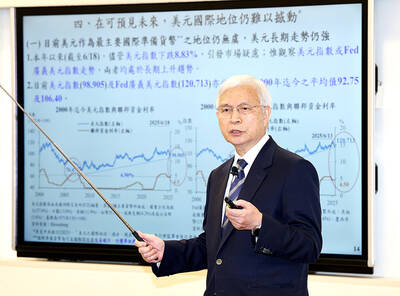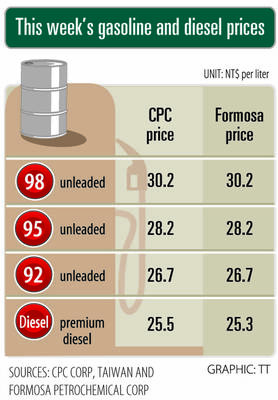Arizona labor unions and Taiwan Semiconductor Manufacturing Co (TSMC, 台積電) have reached an agreement to resolve labor disputes that have dogged the chipmaker’s construction site in Phoenix, Arizona, they said in a joint statement.
The new accord is the result of months of negotiations between the world’s leading chipmaker and the Arizona Building and Construction Trades Council (AZBTC), a coalition of unions with 3,000 members on site — about one-quarter of TSMC’s total construction workforce.
Under the agreement, TSMC — which is investing US$40 billion in Arizona — plans to partner with unions to develop workforce training programs and maintain transparency on safety issues.

Photo: An Rong Xu, Bloomberg
Representatives of both sides are forming a new committee that is to meet quarterly to ensure compliance, including at least one meeting to project workforce requirements.
The joint statement said that TSMC is committed to hiring locally, but that “circumstances may require” the firm to tap foreign workers with “specialized experience.”
TSMC had upset union members this summer by saying a lack of skilled labor in the Phoenix region left the firm with no choice but to bring over workers from Taiwan.
“Today’s agreement is a win for Arizona workers and the construction timeline of TSMC Arizona,” trades council president Aaron Butler said.
“AZBTC union members have the critical skills necessary to help us complete our two advanced-chipmaking fabs, and we look forward to embarking together on a new chapter of partnership and collaboration,” TSMC Arizona president Brian Harrison said.
The accord achieves one of the union’s key goals: getting something on paper before the US Department of Commerce disperses the first round of funding from the Chips Act, with TSMC widely expected to be among the initial recipients.
The Chips Act sets aside subsidies worth US$100 billion to bring manufacturing of critical electronic components back to the US after decades of production abroad.
TSMC was one of Washington’s biggest targets for US investment and the company broke ground on a sprawling facility in Phoenix in 2021.
The firm originally planned to begin mass production next year, but in July announced a delay to 2025 due to what they said was a shortage of skilled labor, rankling the unions.
TSMC chief executive C.C. Wei (魏哲家) in October affirmed that the company plans to start production in Arizona in the first half of 2025.

NOT JUSTIFIED: The bank’s governor said there would only be a rate cut if inflation falls below 1.5% and economic conditions deteriorate, which have not been detected The central bank yesterday kept its key interest rates unchanged for a fifth consecutive quarter, aligning with market expectations, while slightly lowering its inflation outlook amid signs of cooling price pressures. The move came after the US Federal Reserve held rates steady overnight, despite pressure from US President Donald Trump to cut borrowing costs. Central bank board members unanimously voted to maintain the discount rate at 2 percent, the secured loan rate at 2.375 percent and the overnight lending rate at 4.25 percent. “We consider the policy decision appropriate, although it suggests tightening leaning after factoring in slackening inflation and stable GDP growth,”

DIVIDED VIEWS: Although the Fed agreed on holding rates steady, some officials see no rate cuts for this year, while 10 policymakers foresee two or more cuts There are a lot of unknowns about the outlook for the economy and interest rates, but US Federal Reserve Chair Jerome Powell signaled at least one thing seems certain: Higher prices are coming. Fed policymakers voted unanimously to hold interest rates steady at a range of 4.25 percent to 4.50 percent for a fourth straight meeting on Wednesday, as they await clarity on whether tariffs would leave a one-time or more lasting mark on inflation. Powell said it is still unclear how much of the bill would fall on the shoulders of consumers, but he expects to learn more about tariffs

Greek tourism student Katerina quit within a month of starting work at a five-star hotel in Halkidiki, one of the country’s top destinations, because she said conditions were so dire. Beyond the bad pay, the 22-year-old said that her working and living conditions were “miserable and unacceptable.” Millions holiday in Greece every year, but its vital tourism industry is finding it harder and harder to recruit Greeks to look after them. “I was asked to work in any department of the hotel where there was a need, from service to cleaning,” said Katerina, a tourism and marketing student, who would

i Gasoline and diesel prices at fuel stations are this week to rise NT$0.1 per liter, as tensions in the Middle East pushed crude oil prices higher last week, CPC Corp, Taiwan (台灣中油) and Formosa Petrochemical Corp (台塑石化) said yesterday. International crude oil prices last week rose for the third consecutive week due to an escalating conflict between Israel and Iran, as the market is concerned that the situation in the Middle East might affect crude oil supply, CPC and Formosa said in separate statements. Front-month Brent crude oil futures — the international oil benchmark — rose 3.75 percent to settle at US$77.01